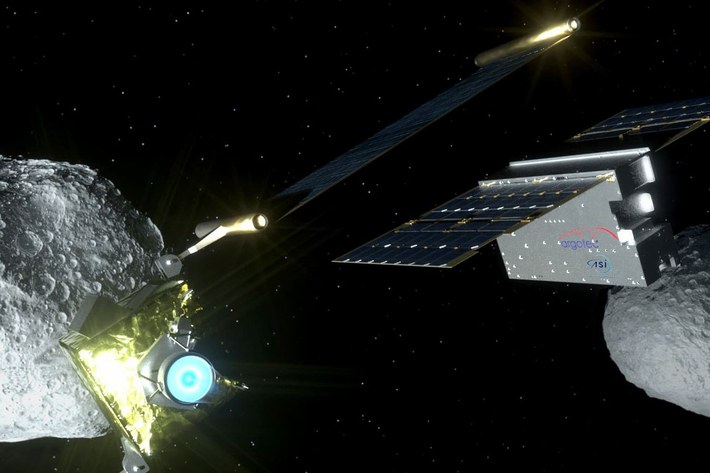Credits: ASI
On 26 September 2022, the Double Asteroid Redirection Test (DART) - an object weighing half a ton launched at 22,500 kilometers per hour - had an impact with Dimorphos (a satellite of the asteroid Didymos), during the first world planetary defense experiment, altering its trajectory. This occurred under the vigilant observation of the cubesat belonging to the Italian Space Agency (ASI), LICIACube (Light Italian Cubesat for Imaging of Asteroids), which, after a year and a half, presents another snapshot of the events that unfolded in the seconds following the impact.
The first spacecraft made in Italy (designed, built, and operated for ASI by the Turin-based company Argotec) is an integral part of the US mission, and the Italian scientific team of LICIACube is coordinated by INAF and ASI in collaboration with the Institute of Applied Physics "Nello Carrara" of the National Research Council (CNR-Ifac), Politecnico di Milano, University of Bologna, and Parthenope University of Naples.
The instruments on board of LICIACube, LUKE (LICIACube Unit Key Explorer) and LEIA (LICIACube Explorer Imaging for Asteroid), have transmitted remarkable data to Earth both before and after the impact.
The results obtained from LICIACube are scientifically significant for the international community, as they represent the only in-situ images collected during the first Planetary Defense mission ever conducted so far. The plumes of Dimorphos resemble the tail of a comet and are generated by the ejecta expelled into space. Unlike comets, however, the "plumes" of Dimorphos were generated artificially.
How did Dimorphos change after the arrival of DART? "It was astonishing that Dimorphos' surface was no longer visible due to the expelled material" - explained Elisabetta Dotto, a researcher at INAF in Rome, the first author of the article and coordinator of the group working on the LICIACube programme since its beginning. Besides witnessing the unique event of an asteroid's deflection through kinetic impact, detailed images of a binary asteroid have been obtained, which may allow us to better understand the nature of these objects. Since asteroids are remnants of an intermediate phase in the process that led to the formation of planets, the acquired data provides important information for studying the early stages of material aggregation that compose the Solar System.
Marco Zannoni, a researcher at the Department of Industrial Engineering (DIN) and technical manager of the activities entrusted to the University of Bologna, comments: "The contribution of the University of Bologna to this project involved the determination and control of the trajectory of LICIACube, based on the tracking data received from NASA's Deep Space Network ground antennas. The biggest challenge was guiding the nanosatellite LICIACube, which was located 10 million kilometers from Earth and traveling at over 6 kilometers per second, to position itself at the right place and time to capture photos of DART's impact with Dimorphos".
Angelo Zinzi, Project Scientist for LICIACube at ASI, commented as follows: The published work can be considered as a starting point for the DART-LICIACube mission and, more broadly, for planetary defense efforts". Thanks to the significant work carried out by the institutions and industries involved in the LICIACube mission, under the coordination of ASI's project team, it has been demonstrated that cubesats are now ready for both technological and scientific missions in deep space. This also proves that Italy is capable of being a leading actor in this context. He added: "LICIACube has enabled the acquisition of images and data that would otherwise have been impossible to obtain, providing a crucial boost to our understanding of the impact event between the DART spacecraft and Dimorphos. It's also important to highlight that all data and data storage and calibration software were managed by the ASI Scientific Data Center (SSDC), using internationally recognised standards for proper data preservation and dissemination. Following this work, other studies are already in the process of being published and/or revised, from which we will obtain a more detailed analysis and understanding of LICIACube's data".
"Thanks to the great work of the scientific team on the images, the Polytechnic University of Milan, collaborating with CNR, has been able to contribute to refining fragment expulsion models and improving the study of their motion evolution in the asteroid binary system," stated Michèle Roberta Lavagna, professor of Flight Mechanics at Polytechnic University of Milan, Department of Aerospace Science and Technology.
The data obtained so far are demonstrating how, even through a small spacecraft, it is possible to gather significant scientific data. They also illustrate how a well-coordinated and cohesive team can achieve unique results of great scientific relevance.

